



Those were the days
Thurs 18th 8:15 pm Undo | An evening with Jean-Gabriel Périot
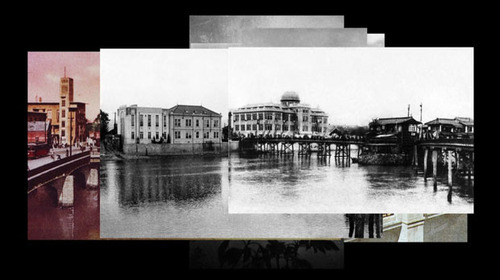
still from: nijuman go borei 200.000 phantoms
When the World Heritage Commission met in 1996 to accord World Heritage Site status to the ruins of Czech architect Jan Letzel’s renamed building – the Atomic Bomb Dome in Hiroshima – America objected, concerned at the nomination’s ‘lack of historical perspective’.
Extraordinarily still standing, despite being just 150 metres from the epicentre of the bomb that ended World War II on 6 August 1945, and since a cornerstone of the Hiroshima Peace Memorial Park, the former Prefectural Industrial Promotion Hall is also the indomitable focal point of Jean-Gabriel Périot’s remarkable Nijuman No Borei (200,000 Phantoms).
The film layers archival photographs of the building from 1914 to the present day, chronologically superimposed on top of each other, pivoting around and anchored by multiple views of the preserved ruin as Current 93’s soundtrack teeters on the brink of a potentially didactic bathos. What pulls this work back from a pacifying nostalgia so convincingly is something that is key to Périot’s work as a whole, an indicator of his common themes and the counterpoint to an uncompromisingly expressed emotional sensibility: that the accumulation of images is a history in which we are complicit; that to accumulate images is profoundly to reconsider history not as a stable, received narrative but precisely to expose it as a collection of myriad perspectives.
This is at the core of 200,000 Phantoms’ beguiling simplicity: as images move from black and white into colour, the building’s skeleton becomes the locus of memorialisation as well as a memorial itself – in actuality and here in its sequential, two-dimensional imprint. It remains, amidst the optimism of modern architecture, the subject of repeated preservation attempts and, significantly, as an image repeated to the extent that it becomes simultaneously, defiantly incontrovertible and, along with time and space, radically almost tangible – in fact, the very materialisation of historical perspective.
Nowhere in Périot’s films is such tangibility better exploited than as in Undo (2005), where footage of contemporary disaster, suppressed protests, violence inflicted, human against human, is simply reversed. The naïve optimism of the film’s formal strategy is caustically undercut by the reality of its documentary material – these things actually happened, these people actually died – such that the work’s willful turning back of time becomes pointedly imaginary and poignantly hopeless.
Périot’s work extends from a politics of the self in his early videos that are ironic exegeses of sexuality. It is deeply affecting not just because of the harrowing and explicit images that it sometimes deploys but also because its absolute indictment of all violence, prejudice and destruction appeals to this imaginary while confronting us with the damning recording of events in our time.
21.04.02 (2002) is a torrid taxonomy of images, an immediate present and a direct response to the election success of the right-wing Jean-Marie Le Pen on that day.
In Even if she had been a criminal (2006), archival footage of World War II rushes past our eyes until we are confronted with deeply disturbing images, not of Nazi atrocities, but of the French cutting off the hair of every woman suspected of collaborating with the German occupiers. Again, ‘we’ are complicit.
If this work is didactic then it is also unashamed, arguing for the necessity of didacticism: an emotional politics that ultimately disorientates and strangely transcends the subjectivity of which it is defiantly constituted.
Ian White is Adjunct Film Curator at Whitechapel, London and an independent curator, writer and artist.

Directors Lounge “MUSEEK No 2” Programme
IMAGE: Still from Lindsey J. Testolin’s “Love in October”
The second Directors Lounge music programme offered a full array of stunning visual charms with videos, such as the more mainstream “House of Cards” – made for Radiohead by James Frost using 3D plotting techniques instead of cameras- to the practically DIY-looking “Fireworks” by Jon Leone for indie favorites Animal Collective.
Also featured was the video for the song “Florian” by CocoRosie animated by Andrew Gibbs as well as a haunting piece for the Icelandic band MÚM’s song “Will the Summer make good for our sins?”
On the lighter side were videos from such lighter Japanese acts as Lullatone with their self-made video “Bedroom Bossa Band” and K+ME for the band Starskee’s song “My Way”.
– Paul J. Thomas
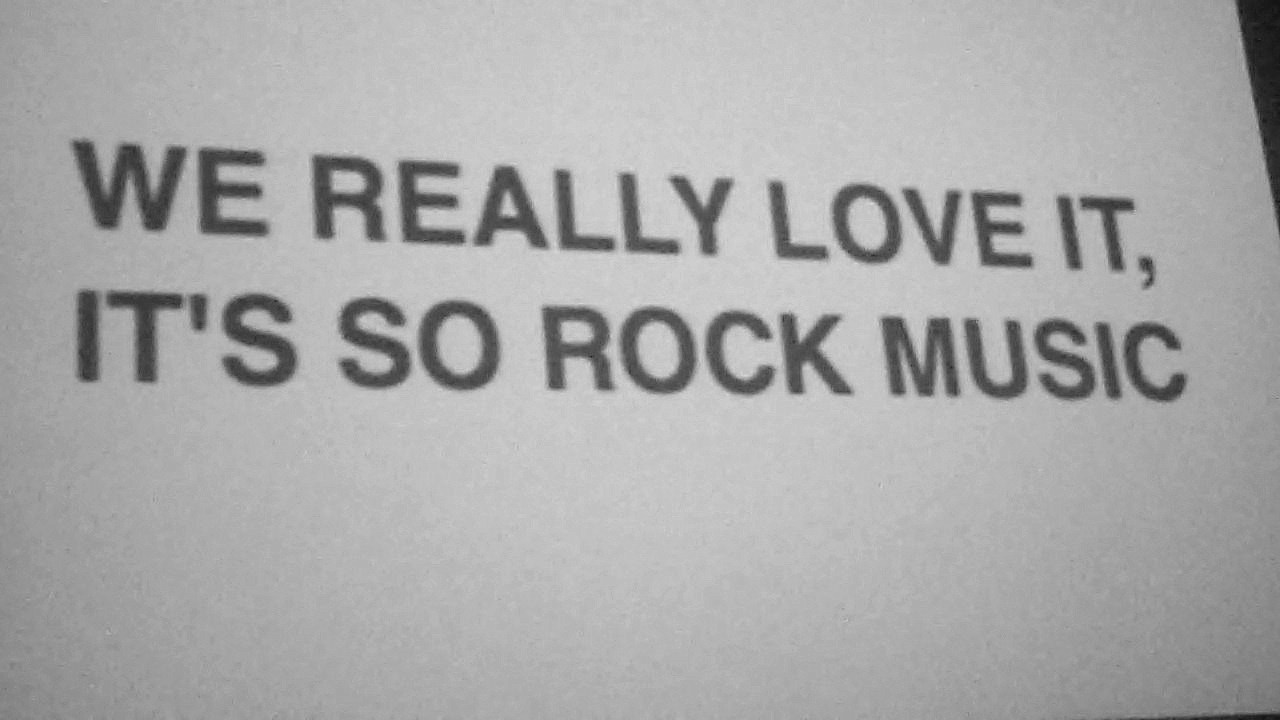
Berlin Directors Lounge: Opening night, February 11, 2010
The opening night of the 6th annual Berlin Directors Lounge provided a well rounded overview of what the 10-day long series has to offer in terms of theme and style. Ranging from the most abstract experimental films to the most light-hearted and even hilarious shorts this roundup of films undoubtedly kept the audience on the edge of their seats not only during the films but also in between as they awaited to see what was to come next.
Works of note which stood out were the “Found People Movement”, a film by Pablo Useros in which people are seen descending a staircase (of a train station?) in slow motion, first looking down at the last few steps the audience then gets a close look at their faces as the unwitting actors reach level ground and look up to get their bearings. What is remarkable about this is the film’s ability to capture completely normal people in an otherwise everyday situation and spin it into a captivating urban mini-opera of sorts –with the help of an accompanying soundtrack.
Neil Needleman’s autobiographic letter to his father about becoming a filmmaker is a sharply bittersweet reflection in which the director recalls his father’s harsh criticism of the director’s choice to buy his first camera through subtitle text on the screen, all the while the audience sees the father in spasms, unconscious on his deathbed. This video was later followed up by what seemed to be another heart-wrenchingly raw an honest (work of fiction?) by the filmmaker called “Meeskeit: Uglier than ugly”, in which a woman describes the strategic placement of her entire family’s likenesses (and their torrid personal histories) in the paintings of her ugly shut-in cousin, who recently committed suicide and willed all of her artwork to the narrator.
Some of the most entertaining pieces of the evening were set to pop music. Antoine Hilaire’s hyper-self conscious video “Cross the Fader” (to the song “Crossfader” by the band phony pony) is nothing but text which describes the song not only musically (with notes) but also dissects the music at each beat and transition in terms of rock-pop history and what might be going through the head of the musician, crowd, or music critic as the power-pop song drives on.
A surprising and terribly fun pop follow up came in the form of Make the Girl Dance’s “Baby Baby Baby”, a music video in which four women take turns walking naked through the streets of paris, their private parts blacked-out with the text of the song superimposed onto the rectangles as passers-by whip around to ogle the gorgeous women as they saunter by in their birthday suits.
Pablo Wendel’s Terracotta Warrior was a particularly humorous film capture’s one performance artist’s 15 minutes of fame as he sneaks in to stand amongst China’s thousands of clay soldiers. The authorities – never having faced such a situation before – simply do not know what to do with the man, and although they attempt to maintain professionalism one can also tell that they are working hard to repress their own laughter at the ridiculousness of the situation. The artist, who all along maintains his stiff clay soldier pose, is until finally hauled away horizontally by a team of the uniformed Chinese guardsmen.
Of the animated pieces that caught my eye, “HAIRS” by Milos Tomic, a film which makes hairs of all sizes spin and dance like one has never seen before.
On of the audience’s favorites, however, was also an animated film – the very simple but effective comedy of errors, Bob Log III’s “Electric Fence Story” by Sebastian Wolf & Tinka Stock . I will not bother to describe this 3-minute masterpiece, which was also included in Friday’s “Cornucopia” programme, but I’d highly recommend that you catch it online.
– Paul J. Thomas

Gestern Abend wurde der erste Block Tomorrow, Night and Day des von Klaus W. Eisenlohrs kuratierten Urban Research Program innerhalb der Directors Lounge präsentiert. Die Auswahl zeigte Arbeiten von internationalen Künstlern, die sich in diesem Block in Form von experimentellen, animierten als auch fiktiven Formaten der Auseinandersetzung mit dem urbanen, öffentlichen Raum widmen.
Das Video von Anders Weberg Elsewhereness:Yokohama (2008) aus der gleichnamigen Reihe, befasste sich mit urbaner Entfremdung, was sich ganz offensichtlich in der Form des präsentierten Videos widerspiegelt. So sieht man in der 7 Minuten langen Arbeit übereinandergelegte, abstrahierte Aufnahmen der Stadt Yokohama. Die mit starkem Kontrast verfremdeten Bilder werden von einer elektronischen, sphärischen Musikkomposition begleitet, was der Arbeit eine hypnotische Qualität verleiht. Das Thema der Entfremdung wird konzeptuell von der Abwesenheit des Künstlers verstärkt, wenn man bedenkt, dass das Rohmaterial der verfremdeten Bilder aus dem Internet recherchiert worden ist und sich der Künstler nie in Yokohama aufgehalten hat. Die manipulierten Aufnahmen werden dadurch zu einer surrealen Reise durch eine entfremdete Landschaft, die auf der Grundlage der kulturellen Vorannahmen und Stereotypen des Künstlers über den Ort basiert. Der Ort bleibt hierbei belanglos, da das Fremde überall zu finden ist. Die einzigen Anzeichen, dass man sich in einer asiatischen Großstadt wiederfindet, sind japanische Schriftzeichen. Die gezeigte Arbeit von Weberg geht von einer anonymen, mechanisierten Zivilisation aus, die mit Hilfe digitaler Medien aus der Distanz erkundet wird. Entfremdung und Abwesenheit werden dabei als Mittel verwendet um die Wahrnehmung des Fremden, dass hier nicht verstanden werden kann und will, erfahrbar zu machen.
Von Martin Tscholl
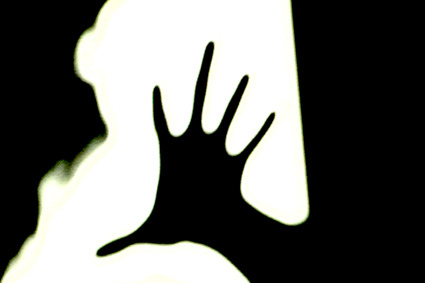
Arthur Tuoto BR Disforme

Neil Needleman US Visions of Wasted Time
It’s impossible to look back at 1985, the year my father died, without feeling bitter about our relationship. To his consternation, I became interested in art, classical music, and shooting/editing moving pictures. These were useless things that didn’t fit into my father’s very practical notion of life. But I am what I am, and I shot what I shot. And I’m still shooting. And I guess I’m still a little bitter. Neil Needleman
The Super 8 camera opens up with a 1985 shot of a beggar/homeless type crouched on a city sidewalk slowly keeling over this way and that, falling into sleep or a stupor while subtitles reveal that the filmmaker has always liked filming wasted time. Next we are in the hospital and camera is turned on the filmmaker’s father, recently pronounced brain-dead, but twitching involuntarily. It’s a macabre sight, all right. It seems dad always thought his son’s filmmaking ventures were a waste of time, and as it is years later still turned on subjects like a man with a sign on his chest staring blankly as pedestrians pass on both sides and a setting sun, the subtitles, directed at dad, aver “It’s still my time to waste, and my world to envision.” A stripped-down piece that makes you think of your time being up, and what you choose to do with it before.
Visions of Wasted Time will be screened as part of Secret Codes | DL mix II Mon 15th 8 pm
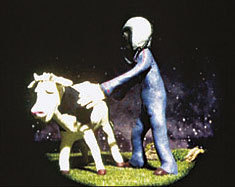
stock`n`wolf / Tinka Stock & Sèbastien Wolf DE Bob Log`s III Electric Fence
This was a funny little bit about one night’s misadventure while “cow-tipping”: pushing over sleeping cows to witness their bovine reaction. The voice narrating is casual and goofy in a charming way, and the tale of getting out of a car drunk in the country at night and walking straight into an electrified fence not once but twice to the imagined guffaws of the cows had the audience laughing out loud, too. Did I mention the story was told with stop motion animation and plasticine figures? An entertaining piece.
Bob Log`s III Electric Fence on screen Sun 14th 8 pm in Stars from Video Palace | Spunk Seipel

Neil Needleman US Meeskeit
A real gem of a story, the uncut diamond variety, was Meeskeit, identified as Yiddish for “uglier than ugly”. The story, told in English as we look at a series of paintings, concerns the woman narrating off-camera, whose sister had a hidden ability, revealed when she left to her a series of paintings in her suicide note. Black humour is mixed with a truly heart-rending tale that reveals itself while we look at the paintings, all containing faces of various relatives in situations she decided to put them in for one reason or another: Uncle Simon romancing his aldulterous wife Rita, who he in reality murdered, along with her lover; “mental case” recluse Schlomo pictured in high society; mother and her bitter rival sister portrayed placidly side by side; the thieving servant toting bibles; Jewish-turned-Christian Uncle Morris as Christ himself in crucifixion. Most poignant is the painting of the two sisters, favourably reproduced as winning beauty queens, and the subsequent revelation of sketches depicting them in the incestuous affair they had, as untouched, unwanted virgin spinsters seeking some kind of love somewhere, after which they spent thirty years with uneasy eye contact. All to be sold to pay for desperately needed chemotherapy, except the sketches of the affair, to be thrown out when the living Meeskeit passes on. All told in a few minutes that are penetrating and hard or impossible to forget.
Meeskeitis part of stories | DL mix IV, Thurs 18th 10 pm

Arthur Tuoto BR Disforme
This bit of shadowplay is not completely uninteresting to watch, but it hardly seems to have a point. If only meant to be a visual pleasure, then enough time wasn’t given to hypnotize us. Someone plays with their fingers and we see only their shadow, spindle-like against a cold white background. A foot is briefly thrown in for good measure. An insistent drone underpins it. What was the intention?
Judge for yourself: Disforme screened in cornucopia | DL mix I, Fri 12th 10 pm
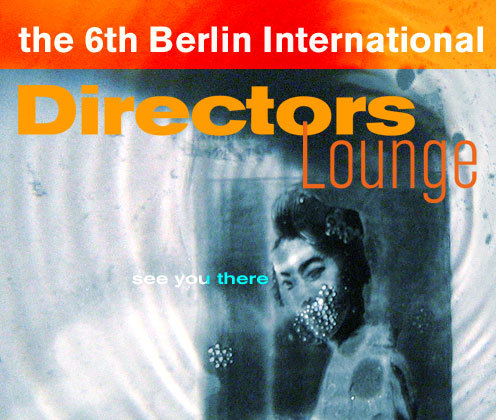
Directors Lounge 2010 | Opening Party | Thurs. 20:00
Berlin’s art and media flâneurs lounge in a new art space at Pfefferberg, Berlin.
At the same time as Berlinale reaches their 60th year, Directors Lounge celebrates her 6th anniversary this February, in 2010. Starting off in 2005 as a spontaneous self-organized place for friends of experimental media arts and for stressed-out film ticket hunters, the small festival has grown to an international platform for exceptional film and media shows. Directors Lounge has presented artists and their works on fairs and exhibitions, features single artists in monthly screenings in Berlin and presents selected works on the web. However, the media art festival in February still is the very heart and core of Directors Lounge, and should not be missed.
As in the past years, for eleven days artist curators from around the world present their selected programs. There is a multitude of highlights to be discovered, special programs, music programs, and of course, you will find a relaxed lounge ambience during the days of film vibes in Berlin. Here, you will meet filmmakers and artists in person. And without stressing for tickets, you will always find something special, apart from the ordinary or marvellous.
It seems merely impossible to give a concise of the upcoming program, however certain stars on the Directors Lounge firmament become clearly visible. Coming up is a monographic programme of Jean-Gabriel Périot, the acknowledged French moralist and film essayist, who was with the festival from its start. Telemach Wiesinger and Andreas Gogol, among others, will present a 16mm film live-performance. There will be specially curated screenings from Russia, Argentina, Finland and Australia. Two themes seem to lure throughout the whole festival programs including the main selection: First, there is the gaze of the flâneur, the point of view of the stroller or the urban explorer, presented in the Urban Research program, and lingering in many other selections. Second, you will find connections between poetry, poetic film and music film, a theme taken up by such programs as the selections from Zebra Poetry Award and Literaturwerkstatt Berlin, the Festival de VideoPoesia from Argentina and the MUSEEK film program selected by Tour de Film from St. Petersburg.
In any case, the daily screenings from 6pm through late night which will be announced just in time, as it has been a festival tradition will serve best eye- and ear candies for the spontaneous film flâneurs as much as for the connoisseurs of experimental delicatessen.
A warm hearted welcome!
From Team Directors Lounge
From 12th through 21th February 2010, daily from 6 pm with open end
Opening: Thursday, 11 Februar at 8 pm
Location: Meinblau e.V., Pfefferberg, Christinenstr. 18/19, D-10119 Berlin
Link: DL 2010 | The 6th Berlin International Directors Lounge